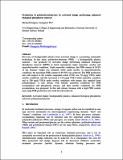Production of polyhydroxybutyrate by activated sludge performing enhanced biological phosphorus removal
Date
2010Author
Rodgers, Michael
Wu, Guangxue
Metadata
Show full item recordUsage
This item's downloads: 2035 (view details)
Recommended Citation
Rodgers, M., & Wu, G. Production of polyhydroxybutyrate by activated sludge performing enhanced biological phosphorus removal. Bioresource Technology, 101(3), 1049-1053.
Published Version
Abstract
In this study, polyhydroxybutyrate (PHB) 'a biodegradable plastics material' was produced by activated sludge performing enhanced biological phosphorus removal (EBPR) in batch experiments under anaerobic, aerobic and anaerobic/aerobic conditions. Under anaerobic conditions, the maximum PHB content of the dry biomass was 28.8% by weight, while under aerobic or anaerobic/aerobic conditions, the maximum PHB content was about 50%. The PHB production rate with respect to the volatile suspended solids (VSS) was: (i) 70 mg/(g VSS) h under aerobic conditions that followed anaerobic conditions, (ii) 156 mg/(g VSS) h under anaerobic condition, and (iii) 200 mg/(g VSS) h under aerobic conditions with energy also supplied from polyphosphate. A side stream, with initially anaerobic conditions for PHB accumulation and phosphorus release, and then aerobic conditions for PHB accumulation, was proposed. In this side stream, biomass with a high PHB content and a high PHB production rate could be both achieved.


